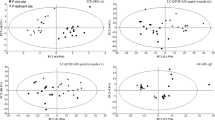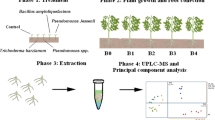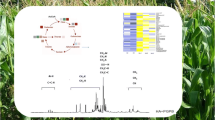Abstract
Key message
Rootstock variety influences leaf metabolic profiles in a grafted citrus tree, but influence also depends on the scion.
Abstract
Proper selection of rootstocks in tree fruit crops such as citrus is important for successful production. Despite a large number of commercially available rootstocks, studies have mostly been limited to basic horticultural observations. We used untargeted gas chromatography-time of flight-mass spectrometry (GC-TOF MS) based metabolomics to understand the biochemical influence of rootstock on 2-year-old field-grown ‘Cara Cara’ navel orange (Citrus sinensis L. Osbeck) and ‘Hirado Buntan’ pummelo (C. grandis L. Osbeck) trees grown on four rootstock cultivars with different genetic background. Five hundred unique metabolites were quantified in all trees, of which 147 were chemically identified. In navel orange trees, 48 root metabolites differed significantly in concentrations among rootstocks, compared with 29 metabolites in pummelo trees. In navel orange trees, raffinose, conduritol beta-epoxide, allantoic acid, myo-inositol, gamma-tocopherol, and beta gentiobiose were among the compounds that contributed most to this variation. In pummelo trees, hexitol, allantoic acid, glucoheptulose, tryptophan, gamma-tocopherol, glycerol-3-galactoside, and raffinose were among the most discriminating metabolites, but only allantoic acid passed significance criteria. Rootstock was also found to influence the quantities of 226 metabolites in leaves of the navel orange scion. Conduritol-beta-epoxide and myo-inositol were among the metabolites most influenced by rootstock. In contrast, the influence of rootstock on the pummelo scion was less prominent, with only six metabolites displaying significant differences. Our findings demonstrate that rootstock variety can influence the metabolic profile of the leaves in a grafted tree, but that the extent of the effect is also influenced by the scion. The majority of root metabolites that discriminated most between rootstocks did not display the same rootstock-specific discrimination in the leaves, suggesting tissue specificity or limited movement across the graft union.









Similar content being viewed by others
References
Abbasi AR, Hajirezaei M, Hofius D, Sonnewald U, Voll LM (2007) Specific roles of α- and ß-tocopherol in abiotic stress responses of transgenic tobacco. Plant Physiol 143:1720–1738. https://doi.org/10.1104/pp.106.094771
Albacete A, Martínez-Andújar C, Martínez-Pérez A, Thompson AJ, Dodd IC, Pérez-Alfocea F (2015) Unravelling rootstock × scion interactions to improve food security. J Exp Bot 66:2211–2226. https://doi.org/10.1093/jxb/erv027
Albrecht U, Bowman KD (2008) Gene expression in Citrus sinensis (L.) Osbeck following infection with the bacterial pathogen Candidatus liberibacter asiaticus causing Huanglongbing in Florida. Plant Sci 175:291–306. https://doi.org/10.1016/j.plantsci.2008.05.001
Albrecht U, Bowman KD (2012) Tolerance of trifoliate citrus rootstock hybrids to Candidatus liberibacter asiaticus. Sci Hortic (Amsterdam) 147:71–80. https://doi.org/10.1016/j.scienta.2012.08.036
Albrecht U, Hall DG, Bowman KD (2014) Transmission efficiency of Candidatus liberibacter asiaticus and progression of Huanglongbing disease in graft-and psyllid-inoculated citrus. HortScience 49:367–377
Albrecht U, Fiehn O, Bowman KD (2016) Metabolic variations in different citrus rootstock cultivars associated with different responses to Huanglongbing. Plant Physiol Biochem 107:33–44. https://doi.org/10.1016/j.plaphy.2016.05.030
Aloni B, Cohen R, Karni L, Aktas H, Edelstein M (2010) Hormonal signaling in rootstock-scion interactions. Sci Hort 127:119–126
Bertolini E, Moreno A, Capote N, Olmos A, De Luis A, Vidal E, Pérez-Panadés J, Cambra M (2008) Quantitative detection of citrus tristeza virus in plant tissues and single aphids by real-time RT-PCR. Eur J Plant Pathol 120:177–188. https://doi.org/10.1007/s10658-007-9206-9
Bollard EG (1957) Translocation of organic nitrogen in the xylem. Aust J Biol Sci 10:292–301
Bowman KD, Graham JH, Adair RC Jr (2003) Young tree growth in a flatwoods rootstock trial with Diaprepes weevil and Phytophthora diseases. Proc State Hortic Soc 116:249–251
Bowman KD, McCollum G, Albrecht U (2016) Performance of “Valencia” orange (Citrus sinensis [L.] Osbeck) on 17 rootstocks in a trial severely affected by huanglongbing. Sci Hortic (Amsterdam) 201:355–361. https://doi.org/10.1016/j.scienta.2016.01.019
Cajka T, Fiehn O (2016) Increasing lipidomic coverage by selecting optimal mobile-phase modifiers in LC–MS of blood plasma. Metabolomics 12:1–11. https://doi.org/10.1007/s11306-015-0929-x
Castle WS (2010) A career perspective on citrus rootstocks, their development, and commercialization. HortScience 45:11–15
Castle WS, Bowman KD, Grosser JW, Futch SH, Graham JH (2016) Florida citrus rootstock selection guide, 3rd edn. http://edis.ifas.ufl.edu/hs1260
Cevallos-Cevallos JM, Rouseff R, Reyes-De-Corcuera JI (2009) Untargeted metabolite analysis of healthy and Huanglongbing-infected orange leaves by CE-DAD. Electrophoresis 30:1240–1247. https://doi.org/10.1002/elps.200800594
Cevallos-Cevallos JM, Futch DB, Shilts T, Folimonova SY, Reyes-De-Corcuera JI (2012) GC-MS metabolomic differentiation of selected citrus varieties with different sensitivity to citrus huanglongbing. Plant Physiol Biochem 53:69–76. https://doi.org/10.1016/j.plaphy.2012.01.010
Chin EL, Mishchuk DO, Breksa AP, Slupsky CM (2014) Metabolite signature of Candidatus liberibacter asiaticus infection in two citrus varieties. J Agric Food Chem 62:6585–6591. https://doi.org/10.1021/jf5017434
Corbesier L, Vincent C, Jang S, Fornara F, Fan Q, Searle I, Giakountis A, Farrona S, Gissot L, Turnbull C, Coupland G (2007) FT protein movement contributes to long-distance signaling in floral induction of Arabidopsis. Science 316:1030–1034
Da Graça JV, Douhan GW, Halbert SE, Keremane ML, Lee RF, Vidalakis G, Zhao H (2016) Huanglongbing: an overview of a complex pathosystem ravaging the world’s citrus. J Integr Plant Biol 58:373–387. https://doi.org/10.1111/jipb.12437
Dong X, Liu G, Wu X, Lu X, Yan L, Muhammad R, Shah A, Wu L, Jiang C (2016) Different metabolite profile and metabolic pathway with leaves and roots in response to boron deficiency at the initial stage of citrus rootstock growth. Plant Physiol Biochem 108:121–131. https://doi.org/10.1016/j.plaphy.2016.07.007
Dubey AK, Sharma RM (2016) Effect of rootstocks on tree growth, yield, quality and leaf mineral composition of lemon (Citrus limon (L.) Burm.). Sci Hortic (Amsterdam) 200:131–136. https://doi.org/10.1016/j.scienta.2016.01.013
Ericsson T, Rytter L, Vapaavuorl FE (1996) Physiology of carbon allocation in trees. Biomass Bioenerg 11(2/3):115–127. https://doi.org/10.1016/0961-9534(96)00032-3
Etxeberria E, Gonzalez P, Achor D, Albrigo G (2009) Anatomical distribution of abnormally high levels of starch in HLB-affected Valencia orange trees. Physiol Mol Plant Pathol 74:76–83. https://doi.org/10.1016/j.pmpp.2009.09.004
Fiehn O, Kopka J, Dormann P, Altmann T, Trethewey RN, Willmitzer L (2000) Metabolite profiling for plant functional genomics. Nat Biotechnol 18:1157–1161. https://doi.org/10.1038/81137
Fiehn O, Wohlgenuth G, Scholz M (2005) Setup and annotation of metabolomic experiments by integrating biological and mass spectrometric metadata. In: Data integration in the life sciences, pp 224–239. https://doi.org/10.1007/11530084
Fiehn O, Wohlgemuth G, Scholz M, Kind T, Lee DY, Lu Y, Moon S, Nikolau B (2008) Quality control for plant metabolomics: reporting MSI-compliant studies. The Plant J 53:691–704. https://doi.org/10.1111/j.1365-313X.2007.03387.x
Folimonova SY, Robertson CJ, Garnsey SM, Gowda S, Dawson WO (2009) Examination of the response of different genotypes of citrus to huanglongbing (citrus greening) under different conditions. Phyopathology 99:1346–1354. https://doi.org/10.1094/PHYTO-99-12-1346
Gargallo-Garriga A, Sardans J, Pérez-Trujillo M, Rivas-Ubach A, Oravec M, Vecerova K, Urban O, Jentsch A, Kreyling J, Beierkuhnlein C, Parella T, Peñuelas J (2014) Opposite metabolic responses of shoots and roots to drought. Sci Rep 4:1–7. https://doi.org/10.1038/srep06829
Goldschmidt EE (2014) Plant grafting: new mechanisms, evolutionary implications. Front Plant Sci 5:1–9. https://doi.org/10.3389/fpls.2014.00727
Gur A, Samish RM, Lifshitz E (1968) The role of the cyanogenic glucoside of the quince in the incompatibility between pear cultivars and quince rootstocks. HorticRes 8:113–134
Joshi V, Fernie AR (2017) Citrulline metabolism in plants. Amino Acids 49:1543–1559. https://doi.org/10.1007/s00726-017-2468-4
Killiny N, Hijaz F (2016) Amino acids implicated in plant defense are higher in Candidatus liberibacter asiaticus-tolerant citrus varieties. Plant Signal Behav 11:1–10. https://doi.org/10.1080/15592324.2016.1171449
Killiny N, Valim MF, Jones SE, Hijaz F (2018) Effect of different rootstocks on the leaf metabolite profile of “Sugar Belle” mandarin hybrid. Plant Signal Behav 2324:e1445934. https://doi.org/10.1080/15592324.2018.1445934
Kusvuran S, Dasgan HY, Abak K (2013) Citrulline is an important biochemical indicator in tolerance to saline and drought stresses in melon. Sci World J. https://doi.org/10.1155/2013/253414 2013.
Lai Z, Tsugawa H, Wohlgemuth G, Mehta S, Mueller M, Zheng Y, Ogiwara A, Meissen J, Showalter M, Takeuchi K, Kind T, Beal P, Arita M, Fiehn O (2018) Identifying metabolites by integrating metabolome databases with mass spectrometry cheminformatics. Nat Methods 15:53–56. https://doi.org/10.1038/nmeth.4512
Maeda H, Song W, Sage TL, DellaPenna D (2006) Tocopherols play a crucial role in low-temperature adaptation and phloem loading in Arabidopsis. Plant Cell Online 18:2710–2732. https://doi.org/10.1105/tpc.105.039404
Molnar A, Melnyk CW, Bassett A, Hardcastle TJ, Dunn R, Baulcombe D (2010) Small silencing RNAs in plants are mobile and direct epigenetic modification in recipient cells. Science (80-.) 328:872–875. https://doi.org/10.1126/science.1187959
Morant AV, Jørgensen K, Jørgensen C, Paquette SM, Sánchez-Pérez R, Møller BL, Bak S (2008) β-Glucosidases as detonators of plant chemical defense. Phytochemistry 69:1795–1813. https://doi.org/10.1016/j.phytochem.2008.03.006
Moreno P, Ambrós S, Albiach-Martí MR, Guerri J, Peña L (2008) Citrus tristeza virus: a pathogen that changed the course of the citrus industry. Mol Plant Pathol 9:251–268. https://doi.org/10.1111/j.1364-3703.2007.00455.x
Mothes K, Engelbrecht L (1952) Über Allantoinsäure und Allantoin. Flora oder Allg. Bot Zeitung 139(17):586–616. https://doi.org/10.1016/S0367-1615 31362–9
Nadernejad N, Ahmadimoghadam A, Hossynifards J, Poorseyedi S (2013) Effect of different rootstocks on PAL activity and phenolic compounds in flowers, leaves, hulls and kernels of three pistachio (Pistacia vera L.) cultivars. Trees 27:1681–1689. https://doi.org/10.1007/s00468-013-0915-8
Nishizawa A, Yabuta Y, Shigeoka S (2008) Galactinol and raffinose constitute a novel function to protect plants from oxidative damage. Plant Physiol 147:1251–1263. https://doi.org/10.1104/pp.108.122465
Pélissier HC, Frerich A, Desimone M, Schumacher K, Tegeder M (2004) PvUPS1, an allantoin transporter in nodulated roots of french bean. Plant Physiol 134:664–675. https://doi.org/10.1104/pp.103.033365
Ramadugu C, Manjunath LK, Halbert SE, Duan YP, Roose ML, Stover E, Lee RF (2016) Long-term field evaluation reveals huanglongbing resistance in citrus relatives. Plant Dis 100:1858–1869. https://doi.org/10.1094/PDIS-03-16-0271-RE
Sengupta S, Mukherjee S, Basak P, Majumder AL (2015) Significance of galactinol and raffinose family oligosaccharide synthesis in plants. Front Plant Sci 6:1–11. https://doi.org/10.3389/fpls.2015.00656
Singh SG, Tuteja N (2010) Polyamines and abiotic stress tolerance in plants. Plant Signal Behav 5:26–33. https://doi.org/10.4161/psb.5.1.10291
Slisz AM, Breksa AP, Mishchuk DO, McCollum G, Slupsky CM (2012) Metabolomic analysis of citrus infection by “Candidatus Liberibacter” reveals insight into pathogenicity. J Proteome Res 11:4223–4230. https://doi.org/10.1021/pr300350x
Soares PR, Marchiosi R, Siqueira-Soares RDC, De Lima RB, Dos-Santos WD, Fettarese-Filho O (2014) The Role of L-DOPA in plants. Plant Signal Behav 9:e28275-1-7
Syvertsen J, Levy Y (2005) Salinity interaction with other abiotic and biotic stresses. Hort. Technol. 100–103
Takahashi H, Imamura T, Konno N, Takeda T, Fujita K, Konishi T, Nishihara M, Uchimiya H (2014) The gentio-oligosaccharide gentiobiose functions in the modulation of bud dormancy in the herbaceous perennial Gentiana. Plant Cell 26:3949–3963. https://doi.org/10.1105/tpc.114.131631
Takishita F (2016) Features of bud dormancy in citrus rootstocks and their mutually grafted seedlings. Acta Hortic 1130:463–468. https://doi.org/10.17660/ActaHortic.2016.1130.69
Tohge T, Watanabe M, Hoefgen R, Fernie AR (2013) Shikimate and phenylalanine biosynthesis in the green lineage. Front Plant Sci 4:1–13. https://doi.org/10.3389/fpls.2013.00062
Wu GA, Terol J, Ibanez V, López-García A, Pérez-Román E, Borredá C, Domingo C, Tadeo FR, Carbonell-Caballero J, Alonso R, Curk F, Du D, Ollitrault P, Roose ML, Dopazo J, Gmitter FG, Rokhsar DS, Talon M (2018) Genomics of the origin and evolution of Citrus. Nature 554:311–316. https://doi.org/10.1038/nature25447
Wutscher HK (2011) Citrus rootstock. Hortic Rev 1(3): 237–269
Xia J, Sinelnikov IV, Han B, Wishart DS (2015) MetaboAnalyst 3.0-making metabolomics more meaningful. Nucleic Acids Res 43:W251–W257. https://doi.org/10.1093/nar/gkv380
Zhou GF, Peng SA, Liu YZ, Wei QJ, Han J, Islam MdZ (2014) The physiological and nutritional responses of seven different citrus rootstock seedlings to boron deficiency. Trees 28:295–307. https://doi.org/10.1007/s00468-013-0949-y
Acknowledgements
We thank Sailindra Patel and Lillian Oglesby for their excellent technical assistance. This research was supported by a grant from the Citrus Research and Development Foundation [project number 15−003]. Mention of a trademark, warranty, proprietary product, or vendor does not imply an approval to the exclusion of other products or vendors that also may be suitable.
Author information
Authors and Affiliations
Corresponding author
Ethics declarations
Conflict of interest
The authors declare that they have no conflict of interest.
Additional information
Communicated by L. Kalcsits.
Electronic supplementary material
Below is the link to the electronic supplementary material.
Rights and permissions
About this article
Cite this article
Albrecht, U., Tripathi, I., Kim, H. et al. Rootstock effects on metabolite composition in leaves and roots of young navel orange (Citrus sinensis L. Osbeck) and pummelo (C. grandis L. Osbeck) trees. Trees 33, 243–265 (2019). https://doi.org/10.1007/s00468-018-1773-1
Received:
Accepted:
Published:
Issue Date:
DOI: https://doi.org/10.1007/s00468-018-1773-1




